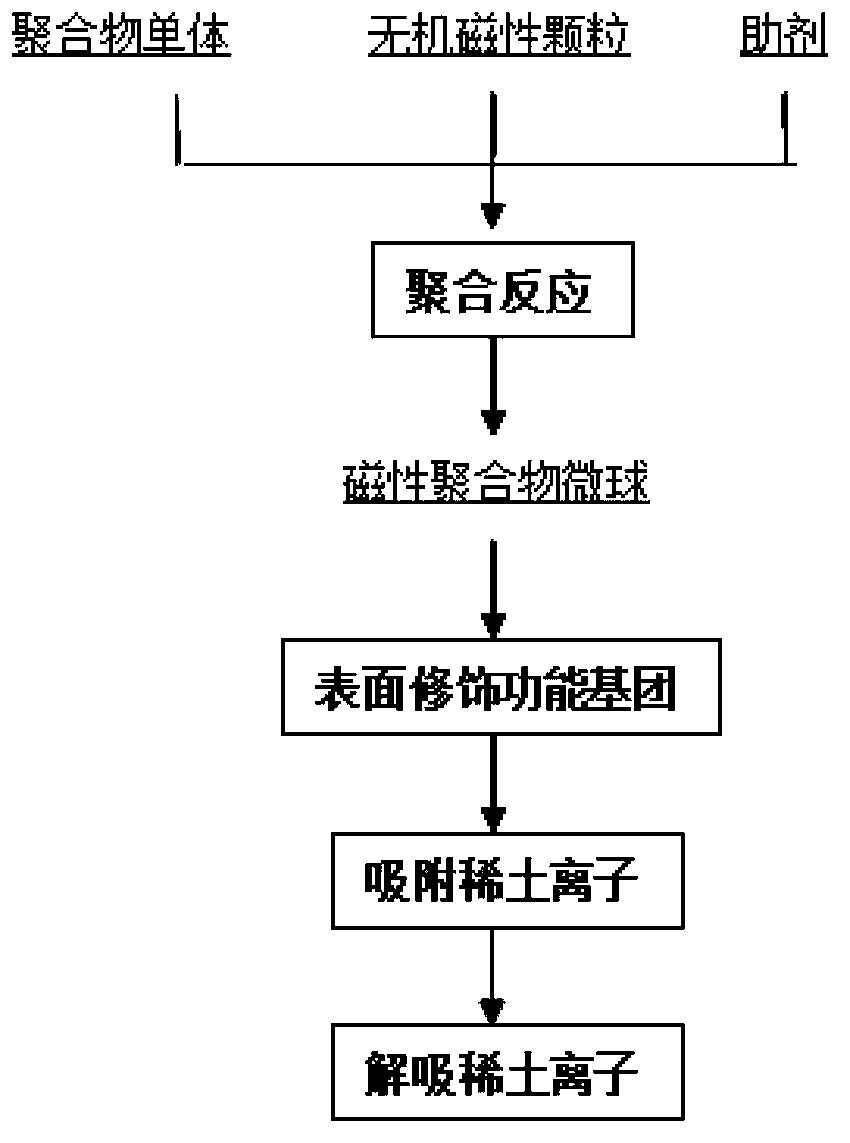Method for using magnetic polymeric microsphere to separate rare earth ions
A technology of rare earth ions and polymers, applied in the direction of improving process efficiency, etc., can solve the problems of slow mass transfer in pores, unsuitable for separating large-volume rare earth ion solutions, and small adsorption capacity, and achieve broad practical application prospects and simple Convenient separation and recovery, large specific surface area
- Summary
- Abstract
- Description
- Claims
- Application Information
AI Technical Summary
Problems solved by technology
Method used
Image
Examples
Embodiment 1
[0019] (1) The prepared particle size is 20 μm, and the Fe-coated 3 O 4 The magnetic polymethyl acrylate (PMA) microspheres (the particle size is less than 8nm, the mass percentage is 20%) were washed twice with N,N-dimethylformamide (DMF), and then 3 g of the microspheres were weighed and added to the In the mixed solution of diamine (EDA) and N,N-dimethylformamide (DMF), the mixture was shaken and shaken, and the reaction was stirred at a constant temperature of 80°C for 8h. After cooling, magnetic separation and washing were performed to obtain magnetic PMA microspheres with surface amination.
[0020] (2) Prepare an aqueous solution of lanthanum nitrate with a concentration of 50 mg / L in a 2000 mL beaker, and adjust its pH to 3.0 with 2 mol / L hydrochloric acid. Weigh the magnetic PMA microspheres with a mass of 2 g surface amination and add 1000 mL La 3+ In the aqueous solution, the adsorption reaction was carried out for 15 min at a temperature of 5 °C and a stirring s...
Embodiment 2
[0023] (1) The prepared particle size is 80 μm, coated with CoFe 2 o 4 (particle diameter is less than 50nm, mass percentage is 10%) the magnetic polymethyl methacrylate (PMMA) microsphere is washed 2 times with DMF earlier, then takes by weighing 10g magnetic microspheres and adds in the mixed solution of EDA and DMF, shakes Shake well and stir the reaction at 80°C for 8h. After cooling, magnetically separate and wash to obtain surface-aminated magnetic PMMA microspheres. Weigh 5 g of the aforementioned magnetic PMMA microspheres grafted with dendritic amino groups on the surface. Added to 16g carbon disulfide (CS 2 ) and 30 mL of 6% sodium hydroxide (NaOH) mixed solution, stirred at room temperature (24° C.) for 2 h, and then continued to react at 45° C. for 4 h. After the reaction, the magnetic PMMA microspheres with dithiocarbamic acid groups connected on the surface are obtained through magnetic separation and washing.
[0024] (2) Take by weighing the magnetic PMMA ...
Embodiment 3
[0027] (1) The prepared particle size is 120 μm, coated with γ-Fe 2 o 3 (particle diameter is less than 30nm, mass percentage is 18%) the magnetic polystyrene-hydroxyethyl methacrylate (P(St-HEMA)) microsphere is washed 2 times with deionized water earlier, then takes by weighing 10g magnetic microsphere Add in 20mL thionyl chloride (SOCl 2 ), react at a constant temperature of 80°C for 8 hours, then add 30 mL of absolute ethanol dissolved with 8 g of sodium p-nitrophenylazosalicylate (AY), and continue the reaction for 24 hours. After cooling, the magnetic P(St-HEMA) microspheres containing AY groups on the surface are obtained by magnetic separation and washing.
[0028] (2) Weigh 2g of magnetic P(St-HEMA) microspheres containing AY groups on the surface in a 5000mL beaker, then add 1200mL of 420mg / L neodymium ion aqueous solution, and adjust its pH with 2mol / L hydrochloric acid The value is 3.5, and the adsorption reaction is carried out for 15 minutes at a temperature o...
PUM
| Property | Measurement | Unit |
|---|---|---|
| Maximum adsorption capacity | aaaaa | aaaaa |
| Maximum adsorption capacity | aaaaa | aaaaa |
| Maximum adsorption capacity | aaaaa | aaaaa |
Abstract
Description
Claims
Application Information
 Login to View More
Login to View More - R&D
- Intellectual Property
- Life Sciences
- Materials
- Tech Scout
- Unparalleled Data Quality
- Higher Quality Content
- 60% Fewer Hallucinations
Browse by: Latest US Patents, China's latest patents, Technical Efficacy Thesaurus, Application Domain, Technology Topic, Popular Technical Reports.
© 2025 PatSnap. All rights reserved.Legal|Privacy policy|Modern Slavery Act Transparency Statement|Sitemap|About US| Contact US: help@patsnap.com

